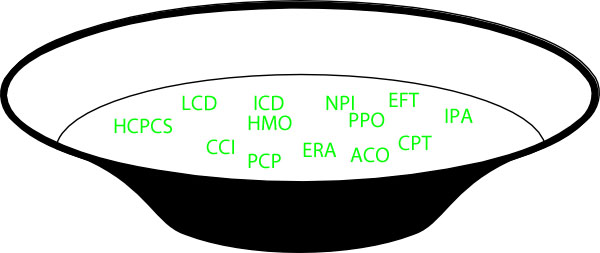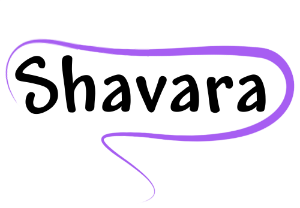Working in medical billing is like being in a bowl of alphabet soup.

One of the probably less common acronyms is MUE: Medically Unlikely Edit.
Read below to find out what an MUE is, and why you should care.
 A medically unlikely edit (MUE) is an automated claim processing edit that compares the number of units submitted for a procedure code against the designated maximum units that are typically reported for that code on the vast majority of appropriately reported claims.
A medically unlikely edit (MUE) is an automated claim processing edit that compares the number of units submitted for a procedure code against the designated maximum units that are typically reported for that code on the vast majority of appropriately reported claims.
 The edit is applied to services billed by a single provider/supplier to a single beneficiary on the same date of service.
The edit is applied to services billed by a single provider/supplier to a single beneficiary on the same date of service.
 The MUE program was developed by CMS in an effort to reduce the paid claims error rate for Medicare claims that result from various circumstances such as:
The MUE program was developed by CMS in an effort to reduce the paid claims error rate for Medicare claims that result from various circumstances such as:
· clerical entries
· incorrect coding based on:
o anatomic considerations
o procedure code descriptors
o procedure coding instructions
o established CMS policies
o nature of a service/procedure
o unlikely clinical treatment
 You can locate a listing of most MUE values on the CMS website: http://www.cms.gov/Medicare/Coding/NationalCorrectCodInitEd/MUE.html
You can locate a listing of most MUE values on the CMS website: http://www.cms.gov/Medicare/Coding/NationalCorrectCodInitEd/MUE.html
 CMS does not publish MUE values for some codes. Some MUE values are confidential and may not be published.
CMS does not publish MUE values for some codes. Some MUE values are confidential and may not be published.
 CMS fiscal intermediaries and Part A/Part B Medicare administrative contractors (A/B MACs) process claims with the fiscal intermediary shared system (FISS). They adjudicate MUEs against each line of a claim rather than the entire claim. If a procedure code is reported more than once, each line with that code is separately adjudicated against the MUE. They will deny the entire claim line if the unit of service (UOS) on the claim line exceeds the MUE value for the procedure code listed on the claim line.
CMS fiscal intermediaries and Part A/Part B Medicare administrative contractors (A/B MACs) process claims with the fiscal intermediary shared system (FISS). They adjudicate MUEs against each line of a claim rather than the entire claim. If a procedure code is reported more than once, each line with that code is separately adjudicated against the MUE. They will deny the entire claim line if the unit of service (UOS) on the claim line exceeds the MUE value for the procedure code listed on the claim line.
 For Example CPT Code 77300 is submitted on one service line for 11 units, if the MUE is 10, then all 11 are denied, instead of a just denying the one unit over the limit.
For Example CPT Code 77300 is submitted on one service line for 11 units, if the MUE is 10, then all 11 are denied, instead of a just denying the one unit over the limit.
 When there is a need to report medically reasonable and necessary units of service in excess of an MUE value modifiers can be used to report the same code on separate lines of a claim will enable a provider/supplier to report medically reasonable and necessary units of service in excess of an MUE value.
When there is a need to report medically reasonable and necessary units of service in excess of an MUE value modifiers can be used to report the same code on separate lines of a claim will enable a provider/supplier to report medically reasonable and necessary units of service in excess of an MUE value.
 The modifiers noted below will accomplish this purpose.
The modifiers noted below will accomplish this purpose.
• 76 — Repeat procedure by same physician
• 77 — Repeat procedure by another physician
• Anatomic modifiers (e.g., RT, LT, F1, F2, 50)
• When is it appropriate to bill modifier 50?
• 91 — Repeat clinical diagnostic laboratory test
• 59 — Distinct procedural service (Note: Modifier 59 should be utilized only if no other modifier describes the service.)
 Effective April 1, 2013, CMS converted some claim line MUEs to date of service (DOS) MUEs. The total units of service (UOS) from all claim lines for a HCPCS/CPT code with the same date of service will be summed and compared to the MUE value. Claims denied based on DOS MUEs may be appealed usingsimilar processes to claim line MUE denials. CMS does not publish which codes have DOS MUEs. Since all UOS for a HCPCS/CPT code on all claim lines with the same date of service are summed, reporting additional UOS on separate claim lines with a HCPCS/CPT modifier will not result in payment of UOS in excess of the MUE value.
Effective April 1, 2013, CMS converted some claim line MUEs to date of service (DOS) MUEs. The total units of service (UOS) from all claim lines for a HCPCS/CPT code with the same date of service will be summed and compared to the MUE value. Claims denied based on DOS MUEs may be appealed usingsimilar processes to claim line MUE denials. CMS does not publish which codes have DOS MUEs. Since all UOS for a HCPCS/CPT code on all claim lines with the same date of service are summed, reporting additional UOS on separate claim lines with a HCPCS/CPT modifier will not result in payment of UOS in excess of the MUE value.


